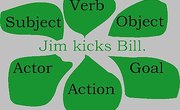Good communication requires an understanding of grammar. Students learn to put sentence parts together correctly to make a comprehensive whole and become fluent commanders of language. An effective way to teach grammar is through the dissection of sentences, which your English teacher calls "sentence diagramming."
Dissection for Comprehension
Getting students to take sentences apart helps them to understand grammar rules. For example, by identifying the subject in a sentence, the student can better see why a verb is conjugated a certain way. Diagramming sentences helps students remove distracting parts or phrases and see the root meaning of sentences. For example, a student might write, "Mom, Dad and me went to the store." However, the diagram reveals that the three subjects who all perform the verb "went" are "Mom went," "Dad went," and "me went," justifying the correction to, "Mom, Dad and I went to the store."
Identify and Dissect
The initial approach to sentence diagramming requires the student to label parts of a sentence. Basic definitions of the parts of speech can help students as they look for each part within a sentence. Nouns are persons, places or things. Verbs are actions. Adjectives describe persons, places or things. Adverbs describe everything except nouns. Starting with these four, and then later adding conjunctions, prepositions, articles, participles, gerunds, and other parts of speech gives students basic sentence comprehension.
Dissect and Group
Once students understand what the parts of speech are, and can identify a word within a sentence and categorize it, they can start to learn how the parts of speech go together. The prepositional phrase, gerund phrase, infinitive, comparative phrase, appositive, and direct object are pieces of sentences that students can learn in this phase of grammar education. In each of these, parts of speech are grouped together in clusters that have meaning when used in a sentence.
Dissect and Diagram
Students that have a firm grasp on what the parts of speech are, how they work together to make phrases, and how those phrases form sentences, can learn to visually construct sentences by diagramming them. Diagramming gives students the ability to graphically demonstrate sentence structure to bring order and meaning to a chaotic English sentence. In a sentence diagram, each part of speech and each sentence cluster have a specific place and format for graphic sentence demonstration. A sentence diagram looks like a tree with branches sticking out of it to indicate the locations and purposes of the various parts of speech.
Related Articles
References
Writer Bio
Meagan Roper has worked in public relations, journalism and the publishing industry. She has a bachelor's degree in public relations and advertising, and a master's degree in interpersonal and organizational communication, both from Liberty University. Roper also has several years of experience teaching college communication courses, and working in information technology and web design.











